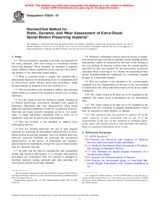We need your consent to use the individual data so that you can see information about your interests, among other things. Click "OK" to give your consent.
ASTM F2624-07
Standard Test Method for Static, Dynamic, and Wear Assessment of Extra-Discal Spinal Motion Preserving Implants
STANDARD published on 15.12.2007
The information about the standard:
Designation standards: ASTM F2624-07
Note: WITHDRAWN
Publication date standards: 15.12.2007
SKU: NS-54267
The number of pages: 11
Approximate weight : 33 g (0.07 lbs)
Country: American technical standard
Category: Technical standards ASTM
Annotation of standard text ASTM F2624-07 :
Keywords:
non-rigid extra-discal motion preserving device, posterior instrumentation, spinal implant, wear assessment, weight loss method, ICS Number Code 11.040.40 (Implants for surgery, prothetics and orthotics)
Additional information
| Significance and Use | ||||||||||||||
|
This test method is designed to quantify the static, dynamic, and wear characteristics of different designs of extra-discal motion preserving implants using testing medium (see 6.1) for simulating the physiologic environment at 37°C. Wear is assessed using a weight loss method in addition to dimensional analyses. Weight loss is determined after subjecting the implants to dynamic profiles specified in this test method. This information will allow the manufacturer or end user of the product to understand how the specific device in question performs under the test conditions prescribed in this test method. This test method is intended to be applicable for extra-discal motion preserving implants. These implants augment the motion/load bearing characteristics between adjacent vertebral bodies, and thereby fully or partially support and transmit motion by means of an articulating joint or by use of compliant materials. Ceramics, metals, or polymers, or combinations thereof are used in implant design, and it is the goal of this test method to enable a comparison of the static, dynamic, and wear properties generated by these devices, regardless of material and type of device. |
||||||||||||||
| 1. Scope | ||||||||||||||
|
1.1 This test method is intended to provide test methods for the static, dynamic, and wear testing of extra-discal motion preserving implants. These implants are intended to augment spinal stability without significant tissue removal while allowing motion of the functional spinal unit(s). 1.2 Wear is assessed using a weight loss method and a dimensional analysis for determining wear of components used in extra-discal spinal motion preserving procedures, using testing medium as defined in this test method (6.1). 1.3 This test method is not intended to address any potential failure mode as it relates to the fixation of the device to its bony interfaces. 1.4 It is the intent of this test method to enable comparison of motion preserving, extra-discal implants with regard to kinematic, functional, and wear characteristics when tested under the specified conditions. It must be recognized, however, that there are many possible variations in the in vivo conditions. A single laboratory simulation with a fixed set of parameters may not be universally representative. 1.5 This test method is not intended to address facet arthroplasty devices. 1.6 This test method prescribes the use of pure angular rotations for assessing the mechanical characteristics of extra-discal motion preserving implants. This test method does not, however, prescribe methods for assessing the mechanical characteristics of the device in translation (for example, anterior/posterior translation), though this type of linear motion may be clinically relevant. 1.7 In order that the data be reproducible and comparable within and between laboratories, it is essential that uniform procedures are established. This test method is intended to facilitate uniform testing methods and data reporting for extra-discal motion preserving implants. 1.8 Without a substantial clinical retrieval history of spinal, motion preserving extra-discal implants, actual loading profiles and patterns cannot be delineated at the time of the writing of this test method. It therefore follows that the motion profiles specified by this test method do not necessarily accurately reproduce those occurring in vivo. Rather this method provides useful boundary/endpoint conditions for evaluating implant designs in a functional manner. 1.9 This test method is not intended to be a performance standard. It is the responsibility of the user of this test method to characterize the safety and effectiveness of the device under evaluation. 1.10 The values stated in SI units are to be regarded as the standard. The values given in parentheses are for information only. 1.11 The values stated in SI units are to be regarded as the standard with the exception of angular measurements, which may be reported in either degrees or radians. 1.12 This standard does not purport to address all of the safety concerns, if any, associated with its use. It is the responsibility of the user of this standard to establish appropriate safety and health practices and determine the applicability of regulatory limitations prior to use. |
||||||||||||||
| 2. Referenced Documents | ||||||||||||||
|
We recommend:
Updating of laws
Do you want to be sure about the validity of used regulations?
We offer you a solution so that you could use valid and updated legislative regulations.
Would you like to get more information? Look at this page.




 Cookies
Cookies
